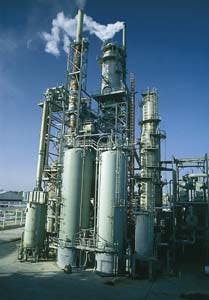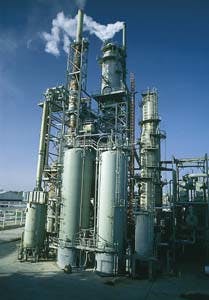Anne K. Rhodes
Refining/Petrochemical Editor
Led by refiners in the Asia/Pacific region, worldwide capacity for conversion processes, such as fluid catalytic cracking, hydrocracking, and coking, increased at a faster pace this year than did crude oil distillation capacity. Crude capacity showed only a small gain of 0.4% to 74.5 million b/d according to the Journals most recent survey of refining capacity.
The refining survey, which begins on p. 47, reflects refinery capabilities as of Jan. 1, 1996. The results reveal an increase in crude capacity of 285,000 b/d. It is important to remember, however, that this net increase occurred despite removal of 11 refineries from the list.
Refinery shutdowns are listed on p. 47. This list includes several refineries that were shut down in late 1993 and 1994, but not reported as closed in last years survey (OGJ, Dec. 19, 1994, p. 45).
Largest refiners
Table 1 (11342 bytes) shows net crude capacity for the worlds 20 largest refining companies. Royal Dutch/Shell leads the list, followed by Exxon Corp. These two companies are continuing to expand their refining assetsShell by 117,000 b/d since last December, and Exxon by 122,000 b/d.
The order of companies in Table 1 (11342 bytes) has changed little since last year, with the following exceptions:
- Mobil Corp. has moved into fifth place, ahead of BP
- Kuwait National Petroleum Co. has moved into fifteenth place, ahead of Total
- Conoco Inc. has moved into nineteenth place, ahead of Sun Co.
These changes are due mainly to incremental expansions at existing refineries. In the case of Mobil, however, an error in calculations last year caused them to be ranked incorrectly as sixth, rather than fifth.
Capacities
The Asia/Pacific region is responsible for most of the 285,000 b/d increase in crude capacity over the past year. Yukong Ltd. expanded its Ulsan, South Korea, refinery by 81,000 b/d. This increase makes the refinery the worlds largest, at 610,000 b/d.
Other major expansions include 57,000 b/d of additional capacity at Singapore Refining Co.s Pulau Merlimau refinery, and a 59,000 b/d expansion at Esso Standard Thailand Ltd.s refinery at Sriracha, Thailand.
Conversion processes
Table 2 (14679 bytes) shows regional capacity totals for key refining processes. Catalytic cracking shows the largest volume increase since last year, with world capacity up 411,000 b/d, or 3.3%. The addition of several new fluid catalytic cracking units, and the expansion of existing ones, caused this increase.
New units include:
- A 23,400 b/d FCC unit at Idemitsu Kosan Co. Ltd.s Tomakomai, Japan, refinery
- A new 31,000 unit at Singapore Refining Co.
- A 38,000 b/d unit at a refinery in Ufa, Russia.
In addition, 14,700 b/d units are now listed at two of Cubas refineries. In previous years, Oil & Gas Journal listed only total crude distillation capacity for Cuba. A Journal source, however, has provided additional details on Cubas refineries.
In addition to these new FCC units, a 35,000 b/d expansion has been completed at Hess Oils Virgin Islands refinery.
Capacity of the worlds hydrocracking units has increased 201,000 b/d, or 6.2%, during the past year. Incremental expansions in most regions are responsible for this increase.
Coke production capacity has increased by 6,400 tons/day, or 5.5%. This increase is due largely to construction of a 52,700 b/d delayed coker at Shell Oil Co.s refinery at Deer Park, Tex. The new unit produces almost 4,500 tons/day of coke.
Fuels processes
Catalytic reforming capacity increased 318,000 b/d, or 3.0%, since the most recent refinery survey. Most of this increase occurred as a result of new units built in the Asia/Pacific region:
- Idemitsu Kosan Co. Ltd. started up an 18,000 b/d continuous-regeneration unit at Tokuyama, Japan.
- General Sekiyu KK started up a 30,600 b/d semiregenerative reformer at Sakai, Japan.
- Nansei Sekiyu KK built a 10,800 b/d semiregenerative unit at Okinawa, Japan.
- Tonen Corp.s Kawasaki, Japan, refinery added a 17,000 b/d semiregenerative reformer and a 26,500 b/d continuous-regeneration reformer.
- Esso Singapore Pty. Ltd. started up a 11,400 b/d semiregenerative reformer.
- Shell Eastern Petroleum (Pte.) Ltd. installed a 30,100 b/d continuous-regeneration reformer, also in Singapore.
- Esso Malaysia Berhad added a 15,400 b/d semiregenerative unit at Port Dickson.
- Petronas added a 20,000 b/d continuous unit at Melaka, Malaysia.
Hydroprocessing capacity (catalytic hydrorefining plus catalytic hydrotreating) has increased 1.24 million b/d, or 3.9%, since last December. (These two categories are compared in combination because refiners tend to move units from one category to another from year to year.)
U.S. hydroprocessing capacity has decreased 196,500 b/d over the past year. Refinery closures account for 104,000 b/d of this loss. Capacity additions have increased hydroprocessing capacity by 197,000 b/d in Western Europe, and by 441,700 b/d in the Asia/Pacific region.
Worldwide capacity in the alkylation/polymerization/dimerization category has increased only 59,000 b/d during the past year. This increase is due mostly to incremental expansions at U.S. refineries, and a new 15,000 b/d sulfuric acid alkylation unit at Mobil Oil Singapore Pty. Ltd.s Jurong refinery.
Processing comparison
Figs. 1,(16390 bytes)2,(16256 bytes)and 3 (20988 bytes) show changes in processing capabilities for, respectively, the U.S., European Union (E.U.), and the Asia/Pacific region. (The countries used to calculate the E.U. figures are listed in Table 3 (33340 bytes). Although Austria, Sweden, and Finland are in the process of joining the E.U., their data are excluded from the calculations, for purposes of historical consistency.)
The graphs are based on the data presented in Table 3 (33340 bytes) and on historical data. They compare capacities of conversion processes (catalytic cracking and hydrocracking) and fuels-production processes (catalytic reforming and alkylation), calculated as a percentage of crude oil distillation capacity. Totaling the capacities of all four of these processes provides a good indication of regional processing capability.
U.S. refiners appear to be leveling off, in terms of sophistication, while European refiners abilities have declined slightly over the past year. Refiners in the Asia/Pacific region have increased their processing abilities by 400,000 b/d, or 9.7%, during the past year.
It should be noted that, in Fig. 3, (20988 bytes) the sudden jump in conversion in 1995 is a result of the availability of new information on Chinas refineries and not because of actual capacity additions. Even so, the region is still far behind North America in conversion capability and will have to make major gains in these important processes to keep pace with its economic boom.
Table 3 (33340 bytes) also compares construction plans for the three regions, as reported by Oil & Gas Journal (OGJ, Oct. 16, p. 65). U.S. and European refiners have little in store for the next 2 years, while Asian processors plan significant additions.
If all reported construction projects are completed as planned, crude capacity in the Asia/Pacific region will increase by 418,500 b/d during 1996. Hydroprocessing capacities are slated to increase by about 336,000 b/dprobably a result of tightening fuel sulfur specifications in the region.
Refinery size
Tables 4a and 4b (42735 bytes) list refining companies with more than 200,000 b/d of crude distillation capacity in the U.S. and Europe.
The list of U.S. refiners has grown, with the addition of Diamond Shamrock. Recent expansions at Diamond Shamrocks Texas refineries have increased the companys total capacity to 210,000 b/d.
Other changes in the U.S. list include:
- Shell moved up two notches to take second place.
- Citgo moved into ninth place, ahead of Marathon.
- Koch jumped up three notches into eleventh place.
- ARCO dropped to thirteenth place from eleventh.
- Fina moved up two places to twenty-second.
The list of European refiners has changed little since last year. The order of companies is identical, and the capacities have changed only slightly.
Table 5 (15696 bytes) compares capacities held by large U.S. refining companies (200,000 b/d distillation capacity) vs. small U.S. companies (
Since the last survey, large refiners have increased their share of U.S. crude capacity, while the small refiners share has decreased. It is interesting that this shift has caused the large refiners share of downstream processing capacity, as a percentage of crude capacity, to decline.
Survey layout
Several changes can be found in the design of this years survey. Additional columns have been added to make room for a column for oxygenates, and to separate coke and asphalt production into two columns. (The two were combined in last years survey.)
In previous years, oxygenates production was listed in a separate table placed in the analysis article (see Table 6, OGJ, Dec. 19, 1994, p. 51). This table contained oxygenates capacities held by nonrefiners, or merchant producers.
World supplies of oxygenates are now adequate to meet increased demand for transportation fuels. For this reason, and because the survey now lists refinery oxygenate capacities, the oxygenates table has been omitted. n
Reprints of any OGJ article or advertisement may be purchased from Reprint Dept., PennWell Publishing Co., Box 1260, Tulsa, OK 74101, 918-835-3161.
Minimum order 100.
Copyright 1995 Oil & Gas Journal. All Rights Reserved.


